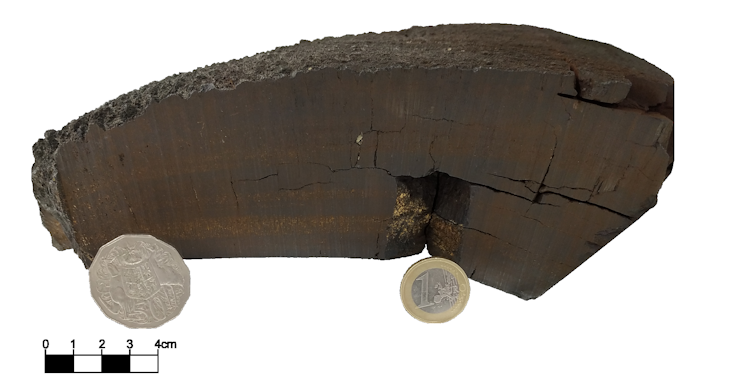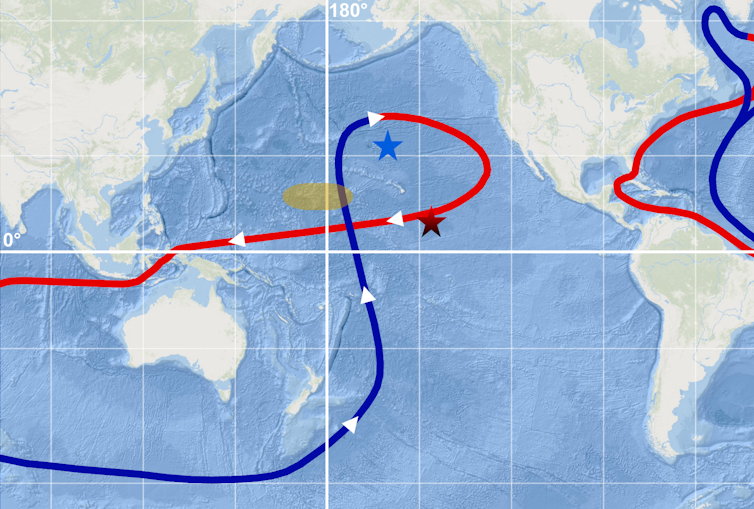
Approximately 10 million years ago, Earth appears to have undergone a remarkable event. Our investigation of rock samples collected from the Pacific Ocean floor has uncovered an intriguing spike in the radioactive isotope beryllium-10 during this period.
This discovery, recently detailed in an article in Nature Communications, paves the way for geologists to better date historical occurrences derived from the ocean’s depths.
However, the reason behind this beryllium-10 anomaly is still unclear. Was it a result of significant alterations in global ocean currents, the death of a star, or perhaps even a collision with an interstellar body?
Slow-growing rocks in the ocean depths
As a researcher, I have been searching for stardust on Earth. Previously, I examined snow samples in Antarctica, but this time, my focus shifted to the ocean’s deep layers.
About 5,000 meters underwater, the abyssal zone of the Pacific Ocean remains in total darkness, yet life still thrives there.
Ferromanganese crusts, metallic formations on the ocean floor, are created when minerals dissolved in water gradually crystallize over extraordinarily long time scales, growing just a few millimeters over a million years. This process is akin to the formation of stalactites and stalagmites in caves, albeit at a much slower rate.
Because of their slow growth, these ferromanganese crusts serve as excellent repositories for stardust accumulated over millions of years.
Scientists can determine the age of these crusts using radiometric dating methods that involve the radioactive isotope beryllium-10. This isotope is perpetually formed in Earth’s upper atmosphere as high-energy cosmic rays collide with air molecules, fragmenting oxygen and nitrogen, which then eventually enter the oceans and become part of the growing ferromanganese crust.

Dominik Koll
One of the most significant ferromanganese crusts was collected in 1976 from the Central Pacific and kept for several decades at the Federal Institute for Geosciences and Natural Resources in Hanover, Germany. A 3.7-kilogram section of this crust became a focal point of my research.
Similar to how tree rings indicate a tree’s age, ferromanganese crusts archive their growth in distinct layers over millions of years. Due to the slow decay of beryllium-10, its presence diminishes over time in older sediment layers. This predictable decay allows scientists to use radioactive isotopes as natural chronometers to ascertain the age and history of various rock formations, a process known as radioactive dating.
A Mysterious Anomaly
Following thorough chemical treatments, my research team employed accelerator mass spectrometry, a highly sensitive method for analyzing long-lived radioactive isotopes, to assess the concentrations of beryllium-10 in the crust.
This research journey took me from Canberra, Australia, to Dresden, Germany, where the facilities at the Helmholtz-Zentrum Dresden-Rossendorf were particularly equipped for beryllium-10 measurements.
Our results revealed that the crust had only developed 3.5 centimeters over the preceding 10 million years and was over 20 million years old.
However, just as I was about to recommence my search for stardust, I stumbled upon an unexpected anomaly.
Initially, as I traced the timeline backward, beryllium-10 levels declined as anticipated, adhering to its natural decay pattern—until roughly 10 million years ago. At that juncture, the rate of decline unexpectedly plateaued before continuing its usual trend around 12 million years ago.
This presented a conundrum: the laws of radioactive decay are stringent, indicating that some external factor must have contributed additional beryllium-10 to the crust during this time.
Skepticism is vital in scientific inquiry. To eliminate any potential errors, I repeated the chemical processing and measurements multiple times—yet the anomaly persisted. Analysis of different ferromanganese crusts located nearly 3,000 kilometers apart yielded the same intriguing result: a beryllium-10 anomaly around 10 million years ago, confirming that this phenomenon was a genuine occurrence rather than a localized anomaly.

Dominik Koll/Map generated with Esri, GEBCO, Garmin, NaturalVue.
Possible Explanations: Ocean Currents or Stellar Explosions?
What might have transpired on Earth to trigger this 10-million-year anomaly? While the precise cause is still uncertain, several hypotheses exist.
Recently, an international study indicated that the Antarctic Circumpolar Current, the primary force behind global ocean circulation, showed signs of intensification around 12 million years ago, potentially altering Antarctic ocean current behaviors.
Could this beryllium-10 anomaly in the Pacific signify the onset of modern global ocean circulation? If ocean currents were indeed responsible, we would expect to see beryllium-10 distributed unevenly across different Earth regions, with some samples lacking the isotope entirely. Obtaining new samples from all major oceans and both hemispheres could help clarify this question.
Another compelling theory surfaced early last year, postulating that a collision with a denser interstellar cloud could have compressed the heliosphere—the Sun’s protective barrier against cosmic radiation—back to Mercury’s orbit. Without this protective shield, Earth would experience a surge in cosmic ray activity, consequently increasing the global beryllium-10 production rate.
A supernova near Earth could also lead to heightened cosmic ray flux, resulting in a similar beryllium-10 anomaly. Future studies will delve into these intriguing possibilities.
The identification of such an anomaly provides a valuable resource for geological dating. Various records are analyzed to understand Earth’s climate, habitability, and environmental conditions across different epochs.
In order to compare archives like ice cores, sediments, ferromanganese crusts, and speleothems (like stalactites and stalagmites), their timescales must align. Independent time markers, such as Miyake events or the Laschamp excursion, serve as invaluable tools for synchronizing ancient records. This discovery could potentially offer a new corresponding time marker spanning millions of years.
Meanwhile, my quest for stardust continues, now with a focus on uncovering additional samples from around 10 million years ago to better understand the beryllium-10 anomaly. Stay tuned for updates!









